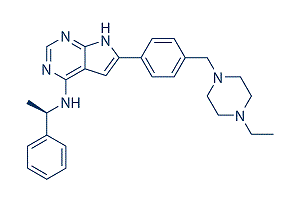| Description: |
AEE788 is an inhibitor of the EGFR and ErbB2 with IC50 values of 2 and 6 nM, respectively. |
| Target: |
EGFR:2 nM (IC50)
ErbB2:6 nM (IC50) |
| In Vivo: |
AEE788 efficiently inhibits growth factor-induced EGFR and ErbB2 phosphorylation in tumors for >72 h. AEE788 also inhibits VEGF-induced angiogenesis in a murine implant model[1]. In mice treated with AEE788, tumor growth is inhibited by 54% at 21 days after the start of treatment compared with control mice[2]. |
| In Vitro: |
AEE788 inhibits EGFR and VEGF receptor tyrosine kinases in the nM range (IC50:EGFR 2 nm, ErbB2 6 nm, KDR 77 nm, and Flt-1 59 nm). In cells, growth factor-induced EGFR and ErbB2 phosphorylation is also efficiently inhibited (IC50:11 and 220 nm, respectively). AEE788 demonstrates antiproliferative activity against a range of EGFR and ErbB2-overexpressing cell lines (including EGFRvIII-dependent lines) and inhibits the proliferation of epidermal growth factor- and VEGF-stimulated human umbilical vein endothelial cells[1]. Treatment of cutaneous SCC cells with AEE788 leads to dose-dependent inhibition of EGFR and VEGFR-2 phosphorylation, growth inhibition, and induction of apoptosis[2]. |
| Kinase Assay: |
The invitro kinase assays are performed in 96-well plates (30 μL) at ambient temperature for 15–45 min using the recombinant glutathione S-transferase-fused kinase domains (4–100 ng, depending on specific activity). [γ33P]ATP is used as phosphate donor and polyGluTyr-(4:1) peptide as acceptor. Assays are optimized for each kinase using the following ATP concentrations: 1.0 μM (c-Kit, c-Met, c-Fms, c-Raf-1, and RET), 2.0 μM (EGFR, ErbB2, ErbB3, and ErbB4), 5.0 μM (c-Abl), 8.0 μM (Flt-1, Flt-3, Flt-4, Flk, KDR, FGFR-1, and Tek), 10.0 μM (PDGF receptor-β, protein kinase C-α, and cyclin-dependent kinase 1), and 20.0 μM (c-Src and protein kinase A). The reaction is terminated by the addition of 20 μL 125 mM EDTA. Thirty μL (c-Abl, c-Src, insulin-like growth factor-1R, RET-Men2A, and RET-Men2B) or 40 μL (all other kinases) of the reaction mixture is transferred onto Immobilon-polyvinylidene difluoride membrane, presoaked with 0.5% H3PO4 and mounted on a vacuum manifold. Vacuum is then applied and each well rinsed with 200 μL 0.5% H3PO4. Membranes are removed and washed four times. Dried membranes are counted. IC50 are calculated by linear regression analysis of the percentage inhibition and are averages of at least three determinations[1]. |
| Cell Assay: |
AEE788 is dissolved in 90% polyethylene glycol 300 plus 10% 1-methyl-2-pyrrolidinone to a concentration of 6.25 mg/mL. Tumor cells are seeded into 96-well plates in complete medium and allowed to attach for 24 hours. The cultures are re-fed with medium with 2% serum. After 24 hours, cells are treated with different concentrations (0-2 μM) of AEE788 (negative control with DMSO alone) for 72 hours. After a 2-hour incubation in medium containing 0.42 mg/mL MTT, the cells are lysed in 100 μL DMSO. The conversion of MTT to formazan is measured at an absorbance of 570 nm[2] |
| Animal Administration: |
Mice: AEE788 is diluted in DMSO and diluted in the optimal medium. BALB/c mice bearing s.c. A-431 squamous tumors (3 animals/group) or HC11-NeuT-driven breast tumors (2 animals/group) are dosed orally with 30 mg/kg of AEE788 or vehicle once daily for 5 days. At different time points after the end of compound treatment and before sacrificing the animals the mice are given i.v. 500 μg EGF/kg body weight or 0.2 ml 0.9% w/v NaCl as vehicle control. Five min after EGF administration, the mice are sacrificed, tumors are removed[1]. |
| References: |
[1]. Traxler P, et al. AEE788: a dual family epidermal growth factor receptor/ErbB2 and vascular endothelial growth factor receptor tyrosine kinase inhibitor with antitumor and antiangiogenic activity. Cancer Res. 2004 Jul 15;64(14):4931-4941.
[2]. Park et al. AEE788, a dual tyrosine kinase receptor inhibitor, induces endothelial cell apoptosis in human cutaneous squamous cell carcinoma xenografts in nude mice. Clin Cancer Res. 2005 Mar 1;11(5):1963-1973. |

 To enhance service speed and avoid tariff delays, we've opened a US warehouse. All US orders ship directly from our US facility.
To enhance service speed and avoid tariff delays, we've opened a US warehouse. All US orders ship directly from our US facility.




















